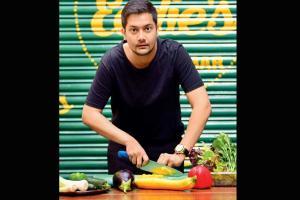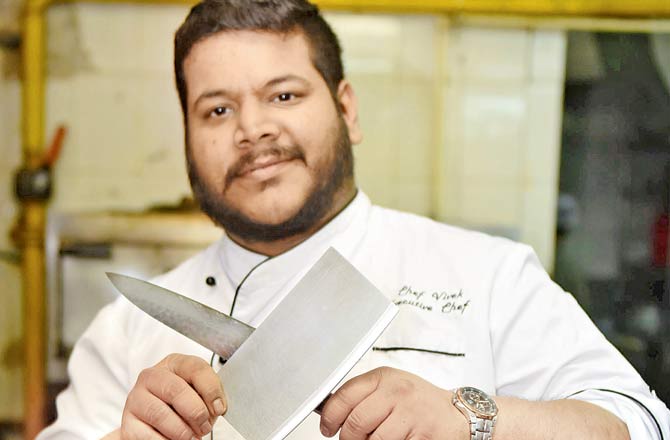Mumbai chefs tell us why the right knife makes all the difference in the kitchen

Nishat Mitra, of Bandra's Eddies Bistro, recalls that his first professsional knife was a clunky wooden one wrapped with a cloth. Now, he has graduated to German and Japanese makes. Pic/Shadab Khan
For Nishant Mitra, head chef at Bandra's Eddies Bistro, hiring a chef entails more than just finding someone who "can cook". It's also about roping in somebody who can slice, dice, chop and butcher to perfection. So, while assessing apprentices, all he does is provide them with vegetables, meat or seafood along with a knife. The way they go about the task can make or mar their prospects.
"If you want to be a cut above the rest, the knife, then, is your weapon," says Mitra, who started his career in the kitchen of Colaba's Leopold Cafe. Here, he was handed a clunky wooden knife wrapped with a cloth that was more cumbersome than cutting edge. But, the stint taught him how to work with knives, which essentially laid the foundation for all the cooking. "Years later, when I graduated to using more sophisticated makes like the German and Japanese, it felt like homecoming," he gushes.
ADVERTISEMENT

Chef Hitesh Shanbhag. Pic/Suresh Karkera
It's a sentiment that culinary experts unequivocally endorse. Knives are a chef's most prized possession, to the extent that you "aren't allowed to touch another chef's knives without permission". "It can get you fired," laughs executive chef Vivek Swamy of Khar's Out of The Blue.
A chef's first love
Touted as the most important kitchen tool, a chef's knives are an extension of their arm. Amusingly enough, chef Subhash Shirke of Neighbourhood Hospitality that includes Colaba's Woodside Inn and The Pantry, Kala Ghoda, even went to the extent of getting a knife tattooed on his right forearm. "Knife skills are what differentiate a chef from a cook. The way you slice, trim and cut is what shows the amount of effort and drive for perfection you have," he says. Also, the way in which it dramatically eases the cooking process, adds Swamy, who picked up knife skills while working at a butchery in Kerala for two years. It took him a while though to find the "right fit", which would sit in his hand like a glove.

The factor to look for is the weight and balance. "The best way to judge is by gripping the knife by its handle. When you hold it next to the wooden part, where you keep you index finger, it needs to balance itself. If it teeters, then it probably isn't for you." Most chefs usually begin their day by sharpening their knives for 15 minutes to half-an-hour on a waterstone with a fine grit (800 to 1,000 grit) to give it a mirror finish. The higher the grit, the greater the sharpness. Meats with a higher fat content like pork require more work as fat erodes sharpness. As a rule, all chefs have the classic eight to ten inch knife with a blade that can handle most tasks. But it never ends there, says chef Raunak Gyani of Navi Mumbai's Asian restaurant Soy Street.
"It's addictive when you start exploring. All chefs have a personal collection that they truly value. I have close to 15 knives that range from a robust Chinese cleaver to an F.Dick knife which is of high quality forged steel, made in Germany," he says. Similarly, Swamy's collection boasts of eight different ones that he picked up during his travels or was gifted by fellow chefs. His most prized though is the Shiro Kamo Gyuto that he picked up after saving up for three months while working in Canada. It has been nine years since he bought it, and a year and a half since he moved to Mumbai, but the knife looks as good as new. "It has 24 layers of high carbon steel that has been compressed into one blade of knife. Naturally, it came for a hefty sum of 350 Canadian dollars," he recalls.

Vivek Swamy’s most prized knife is the Shiro Kamo Gyuto that he picked up after saving up for three months while working in Canada. It has been nine years since he bought it, but the knife looks as good as new. “It has 24 layers of high carbon steel that has been compressed into one blade of knife.” PIC/Bipin Kokate
"It can outlive you"
For most chefs, knives are an investment that can last even 15 years. And, if you use it carefully and sparsely even last a lifetime. "Provided you take care of it," says sous chef Hitesh Shanbaug, The Good Wife. His late grandmother's Victorinox still sits in his kitchen. His own collection consists of 12 knives including Ikkaku Donryu, a heavy all-purpose chef's knife, where the weight of it helps cut through tough meats and vegetables, and Togiharu Misono 440, an ergonomic knife, which is light and can be used for cleaner cuts. He sharpens the knife once a week. "A blunt knife can do more damage than a sharp knife because you're more likely to use force and press through the food you're cutting, which means you're more likely to lose control of the knife."
If you're an at-home cook, your arsenal can consist of two to three smaller, sharp knives that can do the job, believes Nitin Mathur, executive chef, Taj Santacruz. "You can even invest in a jagged or serrated blade because it remains sharp for a long time. You don't need a stone to sharpen them," he says. But he advises on using a separate knife for acidic foods and keeping it dry after use.
Along with sharper knives in their kitty, almost every chef has an equal or more "dark" yet humourous knife stories to tell. "I had lent my knife to one of chefs, and I didn't realise how sharp it was until he ended up cleanly chopping off a part of his nail. While I was aghast, I was also proud of how sharp my knife was," says Swamy. As a sign off, he has a cautionary line. "Never ever try to grab a falling knife."

A guide to knife-picking
. Decide what you need the knife for cutting vegetables, meat or fish
. If buying from a shop, hold the knife in your hand to see if it feels comfortable. It should not be too heavy or too light
. If you are looking at buying a locally manufactured knife, check how much of the knives steel is in the handle. This determines the longevity of the knife (preferred is thin layer of steel embedded in the wooden handle)
. Avoid stainless steel. This tends to rust fast. High carbon stainless steel is what you should look for
Catch up on all the latest Mumbai news, crime news, current affairs, and also a complete guide on Mumbai from food to things to do and events across the city here. Also download the new mid-day Android and iOS apps to get latest updates
 Subscribe today by clicking the link and stay updated with the latest news!" Click here!
Subscribe today by clicking the link and stay updated with the latest news!" Click here!







